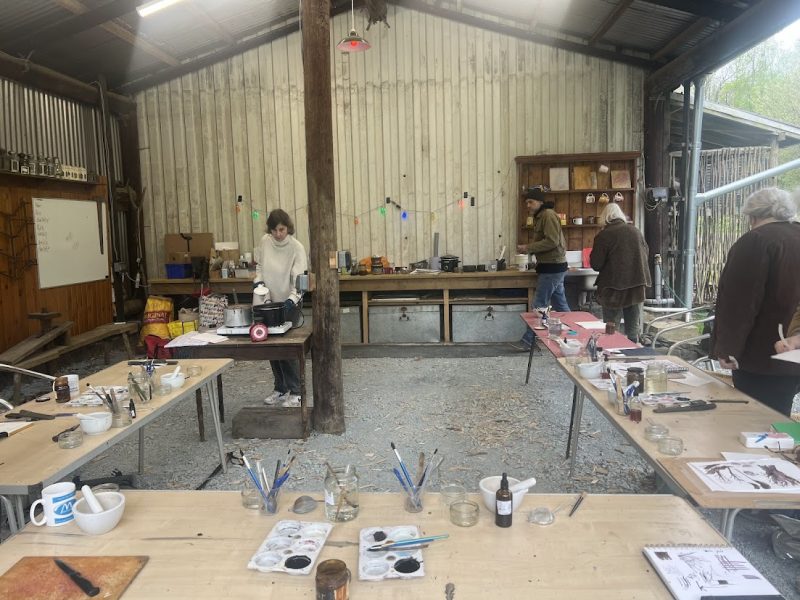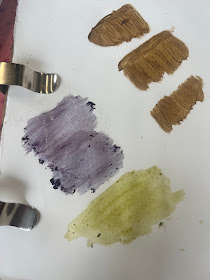Words Amicia de Moubray Photographs Amicia de Moubray
Faversham resident Amanda Thesiger is an alchemist extraordinaire. She creates subtle botanical inks in a myriad of beautiful hues using natural materials, mostly foraged, some shop bought. Natural materials have been used for inks since ancient times.

Amanda Thesiger (on left) teaching enthusiastic students how to make botanical ink in the wonderful outside classroom at Walderchain Wood
Recently I was lucky enough to attend an Ink Making and Drawing workshop taught by Amanda in the bucolic setting of Walderchain Wood near Barham – one of many day courses run by Mark Saich in an outside classroom (it is under cover). On the way, I espied a bank brimming with literally hundreds of cowslips which set the tone for the day.
What is ink? Amanda explained that it is colour suspended in water, further elaborating that inks can be changeable in tone depending on what surface they are used on (the type of paper or canvas), the source of the material, and the time of year. Colour can come from any part of the plant – bark and leaves from trees, even those of the same species, produce different colours depending on where they are grown.

Making botantical inks involves a lot of simmering and stirring
‘Time is a key ingredient when making inks.’ In other words, infinite patience is needed. For example, making delicious dark ink with dried black walnut husks involves cooking them in a slow cooker over several days, occasionally topping up the water. Other inks are faster such as red cabbage: chop one up and then simmer in water for about 15-20 minutes, adding salt and white vinegar. These help to pep up the intensity of the colour as well as preserving it. ‘A lot of basic household substances, cooking ingredients and tools can be used for processing inks.’

A sample of beautiful harmonious colours of botanical inks made from natural ingredients
Some additives like the vinegar mentioned above, can change the colour of certain inks by altering the pH (level of acidity/alkalinity). Others that can do this include baking soda, wood ash, lemon juice and alum (available online). A ‘mordant’ is an ingredient that will fix the colour, more often used with dyeing. The sizing process in papermaking acts in part to do this. A key ingredient for any ink is gum Arabic which acts as a binder for the water and the pigment. It comes from the acacia tree. One clove or a few drops of Wintergreen oil will help to preserve the ink from moulding.
Metals such as iron can deepen colour. Grind oak galls which are rich in tannin, in a coffee grinder to little grains and then steep them in order to release the pigment. A rust solution, made by steeping rusty iron nails or wire wool in white vinegar, and agitated every now and then, is combined with the tannic solution to cause a reaction. The resulting oak or iron gall is indelible and darkens with age. Used on vellum for the American Constitution, early bibles and all sorts of official records, it is only since 1945 that oak gall was replaced with dye-based inks. Surprisingly, green is difficult to create from any plant materials.
Each participant on the course had the opportunity to work with a wide variety of different materials provided by Amanda and to paint the surrounding woodland with the results. Bark, chalk, charcoal, earth pigments, galls, vegetables, fruits were just a few of the ingredients. It was an engrossing day of grinding, sieving, watching the pot boil and experimenting, all spurred on by Amanda’s tutelage. We also learned lots of little tips such as that a few drops of rosemary oil stop skin forming on top of an ink.
Making botanical inks is a great way to connect with nature. Not surprisingly there is a growing interest in natural pigments.

Paintings of Walderchain Wood’s bucolic setting using botanical inks made under the tutelage of Amanda Thesiger
An artist herself, Amanda strongly believes ‘everyone can draw’. She is ‘passionate about pathways that connect us to the natural world.’
A natural teacher, Amanda’s CV is impressive. Regarded as academic at school, Amanda says: ‘I always wanted to make things.’ She took a Foundation Course at Epsom Art College before doing a BA at Maidstone College of Art, followed by a postgraduate at the Royal Academy of Arts before being awarded the Abbey Major Scholarship in Painting at the British School at Rome. Her work has been in numerous exhibitions over the years. She was selected as the Southeast artist for the Brink’s Community Arts ‘Colour in the Margins’ project working with the plants, flowers, trees, mosses, lichens and fungi found in the margins of arable fields at Rochester Court Farm.
Amanda is teaching an Ink-making and Drawing one day workshop on 6 July at Walderchain Wood. Land Marks ink are available to buy via Amanda’s online shop Turpsey.